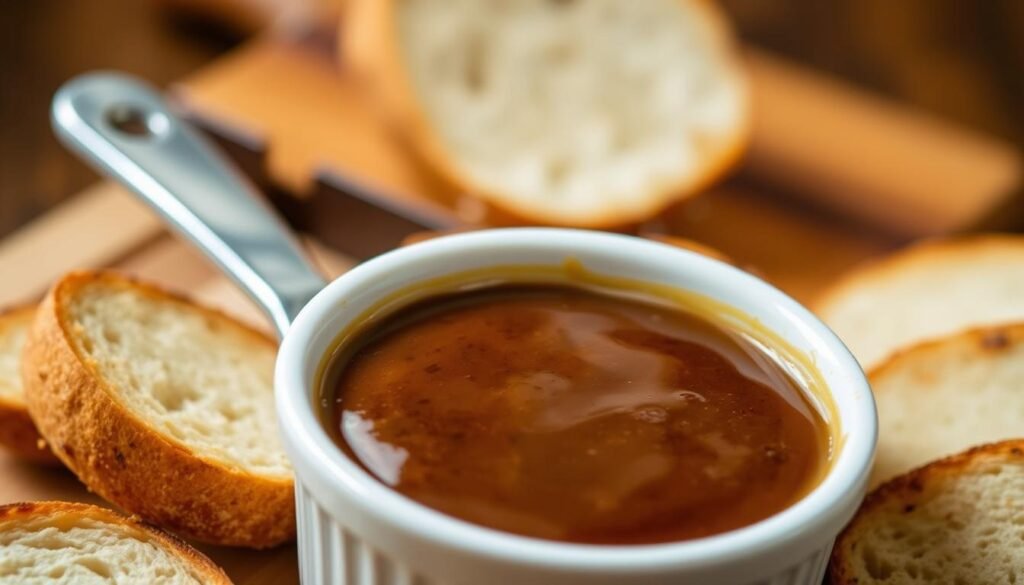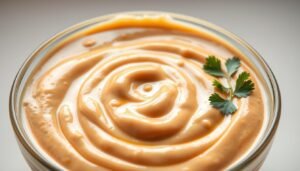Imagine making a dip that can turn any meal into a special treat. Au jus, which means “in juice” in French, is a dish served with its own juices. This delicious homemade dip is great with roasted meats or veggies.
I enjoy trying out new flavors, and this au jus recipe is a top pick. It’s easy to make and adds a lot of taste to any dish. With a few simple ingredients, you can make a tauhu-inspired dish that will be a favorite in your kitchen.
Key Takeaways
- Easy to make with just a few ingredients
- Perfect for accompanying roasted meats or vegetables
- Rich, savory flavor elevates any meal
- Can be used as a dip or a sauce
- Great for meal prep or special occasions
What is Au Jus?
Au jus is a dish served with its own juices. It comes from French cuisine. This method involves serving meat, like roast beef, with the juices left after cooking. Au jus is loved worldwide for making the main dish taste better.
Definition and Origin
Au jus means “in juice” in French. It started in traditional French cooking. Meat is cooked to keep its juices, which are then served with it.
This method adds moisture and deepens the flavor. Au jus is rooted in French cooking traditions, focusing on preserving meat flavors.
Common Uses in Cuisine
Au jus is popular in fine dining and special events. It’s often paired with prime rib, roast beef, or other roasted meats. The juices are collected and served separately, letting diners enhance their meat’s flavor.
In many restaurants, au jus is a key part of the meal. It adds a rich, savory taste. It’s also great with sandwiches and salads.
Differences from Gravy
Au jus and gravy both enhance meal flavors but differ in preparation and texture. Au jus is the juices from cooking meat, while gravy is made by thickening these juices. Au jus is lighter and more like a broth, while gravy is thicker and more robust.
| Characteristics | Au Jus | Gravy |
|---|---|---|
| Preparation | Collected from cooking meat | Made by thickening juices |
| Texture | Light, broth-like | Thick, robust |
| Flavor Profile | Rich, savory | Enhanced, often with additional seasonings |
Knowing these differences helps you see why au jus is special. It can make your meals even better.
Ingredients for a Basic Au Jus Recipe
Making a flavorful Au Jus starts with picking the right ingredients. The ingredients you pick will affect the taste and quality of your Au Jus.
Necessary Ingredients
To make a basic Au Jus, you need these key ingredients:
- Beef Broth: This is the base of your Au Jus. You can use homemade or store-bought broth.
- Red Wine: Optional but recommended for added depth of flavor.
- Beef Drippings: The juices left over from cooking your roast beef are perfect for adding richness.
- Aromatics: Onions, carrots, and celery are commonly used to add flavor.
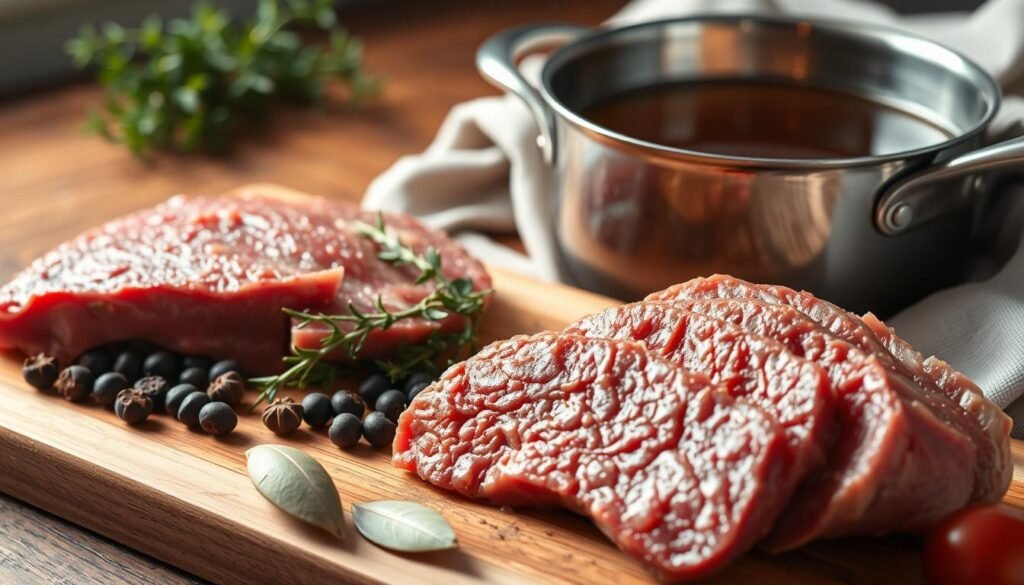
Optional Add-ins for Flavor
To make your Au Jus even better, consider adding these optional ingredients:
- Herbs: Fresh or dried herbs like thyme and rosemary can add a lot of flavor.
- Spices: Black pepper, bay leaves, or other spices can be used to taste.
- Garlic: Minced garlic can be sautéed with the aromatics for added depth.
Recommended Types of Broth
The broth you choose can greatly impact your Au Jus’s flavor. Here are some good options:
| Broth Type | Description | Flavor Profile |
|---|---|---|
| Beef Broth | Made from beef bones and vegetables | Rich, meaty flavor |
| Chicken Broth | Made from chicken bones and vegetables | Lighter, more neutral flavor |
| Vegetable Broth | Made from a variety of vegetables | Light, versatile flavor |
For a traditional Au Jus, beef broth is the most commonly used and recommended type. But, you can try other broths to find your favorite flavor.
Step-by-Step Instructions to Make Au Jus
Making au jus is easy and requires basic ingredients and attention. First, we prepare our ingredients. Then, we cook the au jus and get it just right.
Preparing the Ingredients
To start, we need to get our ingredients ready. We’ll use quality beef broth, butter or oil, and herbs or spices for flavor. Check our previous section for a full list of ingredients.
Key Ingredients:
- Beef broth
- Butter or oil
- Herbs and spices (optional)
For extra flavor, add red wine or sautéed onions and garlic. The French Dip Au Jus recipe is a great inspiration.
Cooking the Au Jus
To cook the au jus, we reduce the beef broth to concentrate flavors. Start by heating butter or oil in a pan over medium heat. Add aromatics like onions or garlic and sauté until they’re softened.
| Step | Action | Time |
|---|---|---|
| 1 | Sauté aromatics | 5 minutes |
| 2 | Add beef broth | – |
| 3 | Reduce broth | 10-15 minutes |
Tips for the Perfect Consistency
Getting the perfect consistency is key for a great au jus. We want it rich and flavorful but still saucy. If it’s too thin, reduce it more or add cornstarch or flour mixed with water.
Tip: Always taste your au jus as you go and adjust the seasoning. A good au jus should enhance the dish it’s served with.
Tips for Enhancing Flavor
Improving your au jus’s taste is easy with herbs, spices, and other ingredients. Let’s look at key elements to boost your au jus’s flavor.
Herbs and Spices to Consider
Choosing the right herbs and spices can really make your au jus better. Thyme, rosemary, and bay leaves are great choices. You can also try black pepper, garlic powder, or paprika for more depth. For example, a tauhu recipe might inspire you to mix spices in new ways.
- Thyme: Adds a classic, slightly minty flavor.
- Rosemary: Provides a piney, aromatic taste.
- Bay leaves: Contributes a mild, savory flavor.
Wine and Other Liquids for Depth
Adding wine or other liquids can make your au jus more complex. Red wine is a top pick because it boosts the beefy taste. You can also use beef broth, stock, or soy sauce for more depth.
“Using a good red wine can make a significant difference in the flavor of your au jus.”
Here are some options to think about:
- Red wine: Rich, bold flavor.
- Beef broth: Enhances the meaty flavor.
- Soy sauce: Adds a savory, umami taste.
Using Leftover Juices
Don’t throw away the juices from cooking your roast. These juices are full of flavor and can enhance your au jus. Just strain them to remove fat, then add them to your au jus for a flavor boost.
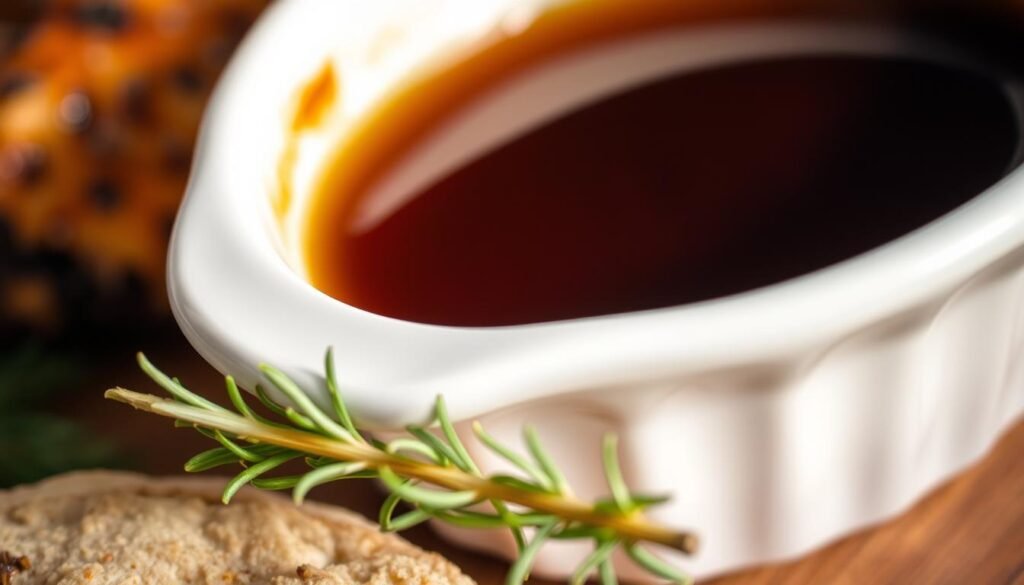
By using these tips, you can make a rich, savory au jus that goes well with many dishes. Try different combinations to find the perfect flavor for you.
How to Serve Au Jus
Elevate your meal with the perfect serving of au jus. Serving au jus is an art that can enhance the overall dining experience. It makes the meal more enjoyable and memorable.
When it comes to serving au jus, the key is to pair it with the right dishes. Some popular options include:
- Prime rib: A classic combination that is both tender and flavorful.
- French dip sandwiches: A delicious match made in heaven, especialy when served with vegan French dip.
- Roast beef: Au jus adds a rich, savory flavor to roast beef.
Best Dishes to Pair It With
Au jus is versatile and can be paired with a variety of dishes. For a unique twist, consider serving it with tauhu or tofu dishes. This adds an Asian flair to your meal.
Serving Temperature Recommendations
The ideal serving temperature for au jus is between 150°F to 170°F (65°C to 77°C). This range ensures that the au jus remains warm and flavorful without being too hot.
Presentation Ideas
Presentation is crucial when serving au jus. Consider the following ideas:
- Serve au jus in a small pitcher or jug alongside the main dish.
- Garnish with fresh herbs like thyme or rosemary for added color and aroma.
- Use a small bowl or ramekin to serve au jus on the side, making it easy for guests to dip their food.
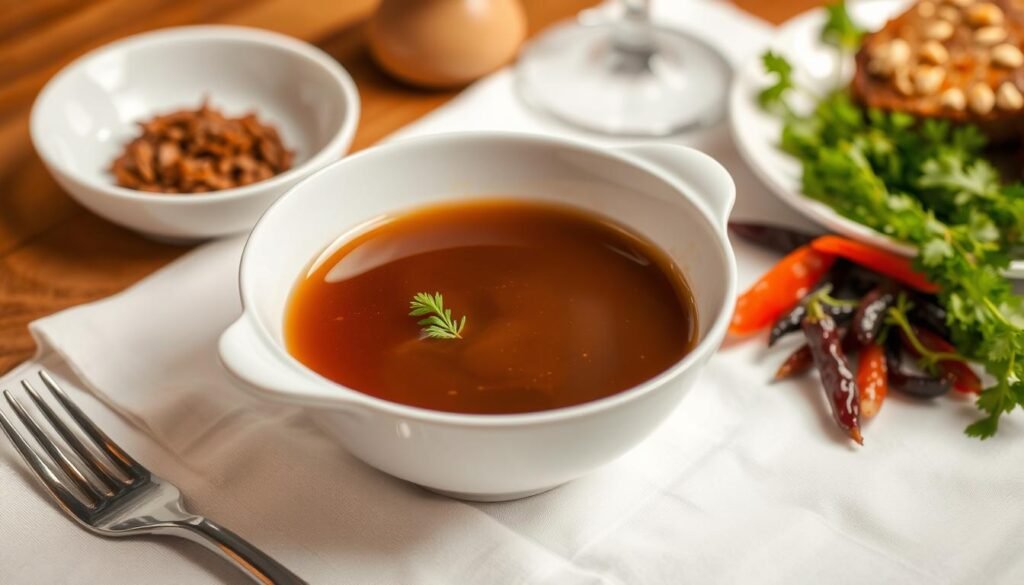
By following these tips, you can serve au jus with confidence. This enhances the dining experience for your guests and makes your meal more enjoyable.
Storage Tips for Leftover Au Jus
Proper storage is key for leftover au jus. It keeps the flavor and quality right. Knowing how to store it correctly makes a big difference.
Refrigeration Guidelines
To store au jus in the fridge, use an airtight container. A glass jar or plastic container with a tight lid works well. Cool the au jus to room temperature before refrigerating to prevent bacterial growth. Once cooled, label the container with the date and store it in the fridge. Au jus can be stored in the fridge for up to 3-4 days.
Freezing Au Jus
Freezing is great for longer storage. Pour the cooled au jus into airtight containers or freezer bags. Make sure to remove as much air as possible before sealing. Label the containers or bags with the date and store them in the freezer. Frozen au jus can be stored for up to 3-4 months. To use it, thaw it overnight in the fridge or thaw it quickly by submerging the container in cold water.
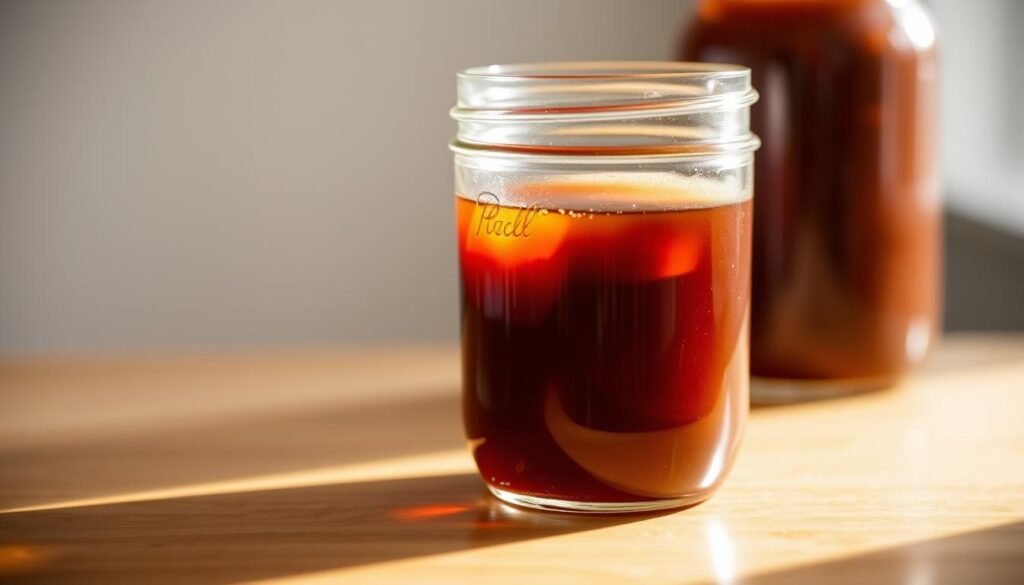
Reheating Methods
Reheating au jus is easy. If refrigerated, pour it into a saucepan and heat it over low heat until warmed through. If frozen, thaw it first and then reheat it. You can also reheat au jus in the microwave, but use a microwave-safe container. Heat it in short intervals, checking until it’s hot and steaming.
| Storage Method | Duration | Reheating Method |
|---|---|---|
| Refrigeration | 3-4 days | Stovetop or Microwave |
| Freezing | 3-4 months | Thaw overnight, then Stovetop or Microwave |
For more au jus recipes, try making a vegan French dip sandwich. It pairs perfectly with a rich and flavorful au jus.
Common Mistakes to Avoid
To make sure your au jus is perfect, you must avoid common errors. It’s not just about following a recipe. It’s also about avoiding mistakes that can ruin its taste and texture.
Overcooking the Stock
One big mistake is overcooking the stock. If you cook it too long, it gets too thick and loses its flavor. To avoid this, watch the cooking time and temperature closely. Simmer the stock gently for 20-30 minutes, or until it’s just right.
Not Straining Properly
Another mistake is not straining the au jus well. If you don’t, it can be cloudy and have unwanted particles. To fix this, use a fine-mesh sieve or cheesecloth to remove solids. This makes your au jus clear and refined.
Skipping Taste Tests
Skipping taste tests is a common error. Taste tests help you adjust the seasoning and flavor of your au jus. By tasting it often, you can make sure it’s balanced and tasty. Don’t hesitate to add more herbs, spices, or seasonings if needed.
| Mistake | Consequence | Solution |
|---|---|---|
| Overcooking the Stock | Too thick, loss of flavor | Simmer gently for 20-30 minutes |
| Not Straining Properly | Cloudy au jus with particles | Use a fine-mesh sieve or cheesecloth |
| Skipping Taste Tests | Imbalanced flavor | Taste regularly and adjust seasoning |
By knowing these common mistakes and avoiding them, you can make a delicious au jus. It will enhance your favorite dishes.
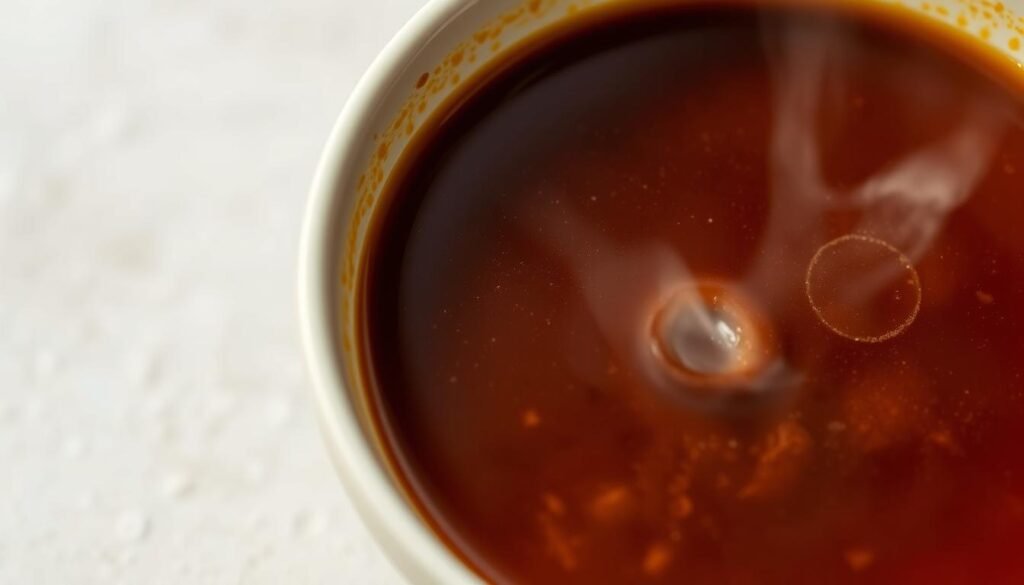
Variations of Au Jus Recipes
Cooking is fun when you try new things. You can make au jus in many ways. This lets you create tasty and unique dishes.
Vegetarian Au Jus
For a vegetarian option, use vegetable broth instead of beef broth. Mushrooms like shiitake or cremini add flavor. Thyme and rosemary herbs make it even better.
Wine-Based Au Jus
Wine can make your au jus taste fancy. Red wine is good with beef, and white wine goes well with chicken or pork. Just deglaze your pan with wine, then add broth.
This method makes a rich, flavorful au jus. It’s sure to impress your guests.
For a wine-based au jus, use the cooking liquid from your roast. It often has wine, adding depth to your dish.
Spicy Au Jus Recipes
Want something spicy? Add hot sauce, red pepper flakes, or diced jalapeños. It’s perfect for those who love spicy food.
To balance the heat, add a bit of sweetness. Honey or brown sugar works well. It creates a mix of flavors that’s exciting.
Frequently Asked Questions (FAQ)
Making au jus can raise several questions. From choosing the right broth to serving it correctly, I’ll address some common queries. This will help you navigate the world of au jus with confidence.
Can I Use Store-Bought Broth?
Yes, you can use store-bought broth as a convenient alternative. But, the flavor might be slightly different. This is because commercial broths have preservatives and more salt.
If you choose store-bought broth, go for a low-sodium version. This way, you can better control the seasoning of your au jus.
How Long Does It Last?
The shelf life of au jus depends on storage. If refrigerated, it can last 3 to 4 days. When frozen, it can last up to 3 months.
Always check for signs of spoilage before consuming. Look for off smells or mold.
Can I Thicken Au Jus?
Yes, you can thicken au jus to your liking. You can reduce it by simmering, or use a slurry of cornstarch or flour mixed with water. Another option is a roux, but it will change the flavor a bit.
Here’s a quick comparison of thickening methods:
| Method | Effect on Flavor | Ease of Use |
|---|---|---|
| Reduction | Minimal | Easy |
| Cornstarch Slurry | Neutral | Moderate |
| Roux | Rich, slightly nutty | More involved |
For a visual guide on preparing au jus, consider the following image:
By understanding these aspects of au jus, you can enhance your culinary experience. Enjoy this delicious dip to its fullest potential.
Conclusion: Enjoying Your Au Jus
As we wrap up this guide, I’m excited for you to start making your own delicious au jus at home. With the steps and tips provided, you’re now equipped to elevate your meals with this savory dip.
Key Takeaways
We’ve covered the basics of au jus, from its definition to the simple steps for preparation. You can now confidently experiment with different flavors and ingredients to create your perfect au jus.
Exploring New Flavors
Don’t be afraid to try new combinations, such as adding a twist with a tauhu recipe or exploring various herbs and spices. The versatility of au jus makes it a great canvas for culinary creativity.
Serving Suggestions
Whether you’re serving au jus with prime rib, French dip sandwiches, or as a dip for your favorite snacks, the possibilities are endless. Enjoy the rich, savory flavor it brings to your dining experiences.

